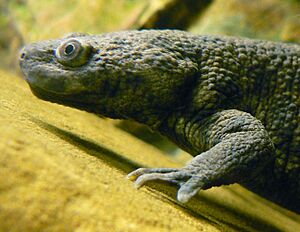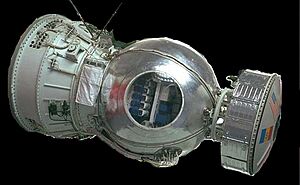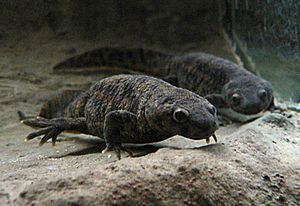Iberian ribbed newt facts for kids
Quick facts for kids Iberian ribbed newt |
|
|---|---|
 |
|
| Pleurodeles waltl in an aquarium | |
| Conservation status | |
| Scientific classification | |
| Genus: |
Pleurodeles
|
| Species: |
waltl
|
 |
|
| Distribution in the Iberian peninsula and the Maghreb | |
| Synonyms | |
|
Pleurodeles waltlii (incorrect spelling) |
|
The Iberian ribbed newt, also called the gallipato or Spanish ribbed newt (Pleurodeles waltl), is a special kind of newt. It lives only in the central and southern parts of the Iberian Peninsula (which includes Spain and Portugal) and in Morocco. This newt is the biggest newt species in Europe. It's also famous for its sharp ribs. These ribs can poke through its sides! Because of this, it's sometimes called the sharp-ribbed newt.
Don't mix up this newt with the Iberian newt (Lissotriton boscai). That's a different species, even though their names sound similar.
Contents
Meet the Iberian Ribbed Newt: Appearance and Defense
The Iberian ribbed newt has small bumps, called tubercles, along each side of its body. Its sharp ribs can push right through these bumps. This is a clever way the newt protects itself. It doesn't hurt the newt when its ribs poke out.
When the newt pushes its ribs out, it also releases a special liquid. This liquid is a mild poison from glands on its body. The ribs, covered in this liquid, become a very effective stinging tool. They can inject the liquid into a predator's mouth through its thin skin. But don't worry, this defense is completely harmless to humans. The newt's body is amazing. It has a strong immune system and special collagen on its ribs. This helps its skin heal quickly without getting infected.
In the wild, these amphibians can grow up to 30 centimeters (about 12 inches) long. However, in tanks, they usually don't get bigger than 20 centimeters (about 8 inches). Their back is dark gray, and their belly is lighter gray. They have small, rust-colored spots where their ribs can stick out. This newt has a flat, spade-shaped head. Its long tail is about half the length of its body. Male newts are usually thinner and smaller than females. Young newts, called larvae, have fluffy gills outside their bodies. They are often lighter in color than the adult newts.
Pleurodeles waltl loves water more than many other European amphibians with tails. Even though they can walk on land, they usually stay in the water. They often live in ponds, old water tanks, and ancient village wells. These were common in Portugal and Spain in the past. They like cool, calm, and deep water. There, they eat insects, water snails, worms, and tadpoles.
Reproduction: How Temperature Can Change Sex
Newts have sex chromosomes that usually decide if they will be male or female. Females have two different sex chromosomes (Z and W). Males have two of the same (ZZ). But for the Iberian ribbed newt, temperature can also play a big role!
If young newts (larvae) with ZW chromosomes are kept at 32°C (90°F) during certain growth stages, they can become males. These males can even have babies! Special body chemicals, called hormones, are important in this process. Scientists can even change a newt's sex by adding hormones to the water it lives in.
Protecting the Iberian Ribbed Newt
The IUCN (International Union for Conservation of Nature) has listed the Iberian ribbed newt as Near Threatened since 2006. This means their numbers in the wild are dropping a lot. They are close to being listed as Vulnerable. Before 2006, in 2004, they were listed as Least Concern, which is the lowest risk.
Why are their numbers going down?
- Loss of homes: Many of their water homes are being drained.
- Pollution: Chemicals from farms and industries pollute their water.
- Livestock: Farm animals can damage their habitats.
- Dirty water: Water becoming too rich in nutrients (eutrophication) or getting dirty from homes and factories.
- New buildings: Golf courses and other buildings take away their natural spaces.
- Busy areas: They have mostly disappeared from coastal areas and big cities like Madrid.
Other animals are also a problem. Fish like the largemouth bass and crayfish (Procambarus clarkii) eat the newt's eggs and young. This also causes their numbers to drop. Sadly, many newts also get run over by cars on roads. This is a serious threat to some groups of newts.
Newts in Space: Amazing Discoveries!
The Iberian ribbed newt (Pleurodeles waltl) has been studied in space on at least six missions! The very first newts went to space in 1985. They were on a Soviet Kosmos satellite called Bion 7. Ten newts shared their trip with two monkeys and ten rats. Later, newts also flew on Bion 10 in 1992 and Bion 11 in 1996.
French scientists continued studying these newts in space. They did experiments on the Mir space station in 1996, 1998, and 1999. In 2005, the newts also flew on the Foton-M2 mission.
Why were newts chosen for space? They are great "model organisms" for studying microgravity (what it's like to be in space with very little gravity). Here's why:
- Female newts can store live sperm for up to five months. This means they can be made pregnant on Earth. Then, in space, scientists can make them lay eggs using special hormones.
- Their babies develop slowly. This allows scientists to watch all the important stages of growth, from egg to swimming young newts.
Scientists looked at how well the newts could regrow body parts in space. They found that regeneration was faster in space, especially in the early stages. They also studied how newts developed and reproduced in space.
Back on Earth, scientists also studied how high gravity (up to 3 times Earth's gravity) affected newt reproduction. They also checked if the newts born in space could have babies once they returned to Earth. Good news: they could, and they had no problems! Other animals, like the Japanese tree frog (Hyla japonica), have also been studied in space. Scientists found no long-term health problems for them either.
Regeneration: The Newt's Superpower
The Iberian ribbed newt is a fantastic animal for studying regeneration. Regeneration means the ability to regrow lost or damaged body parts. Like other salamanders, P. waltl can regrow many things. They can regrow lost limbs (arms and legs). They can also fix injured heart tissue and damaged brain cells. Plus, they can regrow parts like their eye lens and even their spinal cord!
Scientists have even mapped out the newt's entire genetic code, called its genome. This helps them understand the special genes that give the newt this amazing ability to regenerate.
See also
- List of Mir Expeditions
- Animals in space




